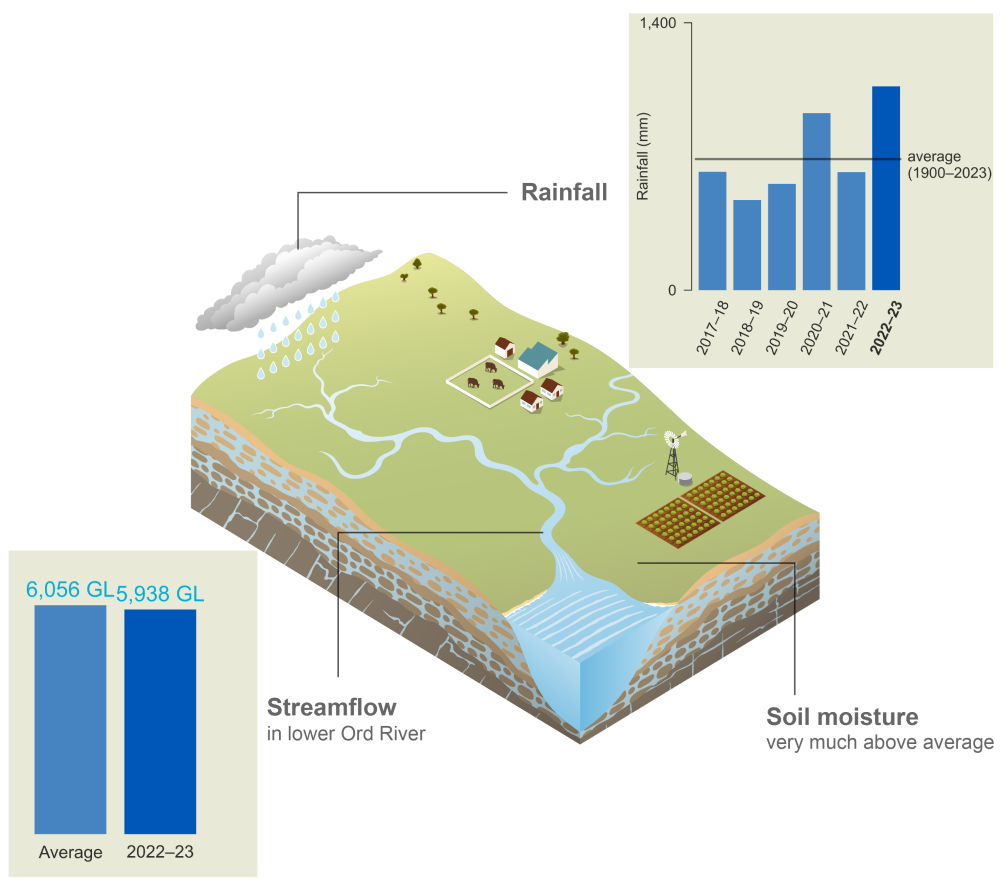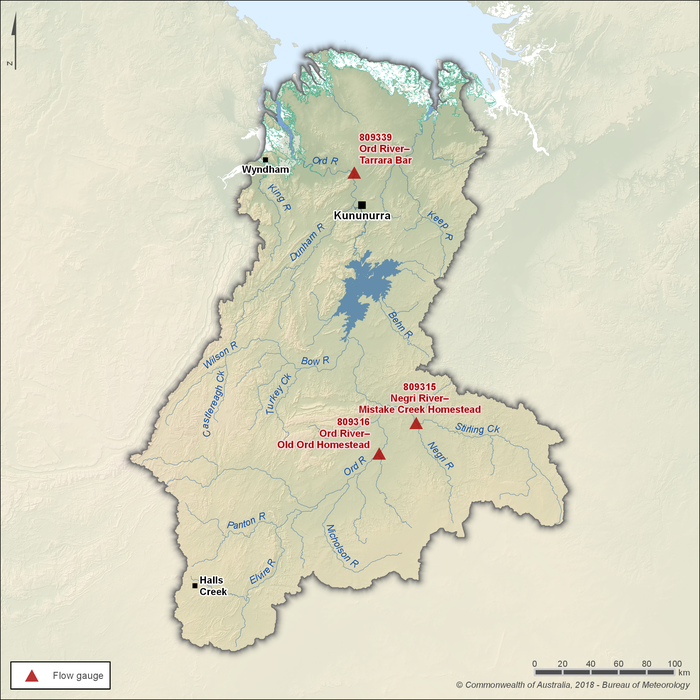Ord: Climate and water
For the water account period 01 July 2022 - 30 June 2023
- Total annual rainfall during the 2022-23 year was above average and the sixth highest on record for the region.
- With the influence of a La Niña event, the 2022-23 wet season was much wetter than average.
- Soil moisture in the root zone (0-1m depth) was very much above average in most areas.
- Total annual flows in the region's major rivers were above average in the Negri River and upper Ord River.

For further information on the region's climate and water conditions during the 2022-23 year scroll down this page or click on the links below:
About the region
- The Ord region has a tropical climate, characterised by hot and humid summers, and warm and dry winters.
- Almost all of the region's rainfall occurs during the northern Australian wet season (October to April).
- Streamflows in the Ord River, downstream of Lake Argyle, are regulated by releasing water from Lake Argyle to maintain minimum environmental flows in the lower Ord River. Consequently, flows in the lower Ord River are perennial, unlike streamflows upstream of Lake Argyle, which can cease to flow during the dry season (May to September).
Climate conditions
Rainfall
Figure C1 Annual and monthly rainfall deciles for the Ord region during the 2022-23 year
- Total area-averaged rainfall for the 2022-23 year was 1,067 mm, 56% above the mean value of 685 mm. This was the region's sixth wettest year on record and the highest annual total since 2016-17.
- In September 2022, a third consecutive La Niña event was declared active in the tropical Pacific Ocean (Climate Driver Update) and remained active through to March 2023. La Niña events tend to increase the chances of above-average rainfall during the northern wet season and likely influenced the well above average rainfall experience in the region through spring and summer.
- Widespread showers and thunderstorms throughout November 2022 resulted in more than three times the monthly average rainfall and the region's second wettest November on record.
- This was followed by a monsoonal burst and the remnants of Tropical Cyclone Ellie bringing widespread rain, thunderstorms and flooding to the region during late December 2022 and early January 2023.
- A strong Madden-Julian Oscillation (MJO) pulse was over the western Pacific in mid February, likely supporting monsoonal activity over northern Australia.
- Tropical Low 16U crossed the region during late February 2023, causing further widespread heavy rainfall and flooding, particularly northern half of the region.
- The 2022-23 wet season was the region's eighth wettest wet season on record, contributing to 97% of the region's total area-averaged rainfall for the 2022-23 year. Much of this rainfall was over the catchment area for Lake Argyle which saw the water level rise by 7 m by the end of February. More information on Australia's 2022-23 Northern Wet Season can be found at: Australia's 2022-23 Northern Wet Season.
- It was a very dry start to the 2023 dry season with no rainfall during May 2023, however, a northwest cloud band brought unseasonable rainfall during June 2023.
- More information on Australia's climate and water over the 2022-23 year can be found at: Financial year climate and water statement 2022-23.
Figure C2 Total monthly rainfall for the Ord region during the 2022-23 year compared with the average and percentiles for the region
- Wet-season rainfall (October 2022 to April 2023) was very much above average, with November 2022, December 2022 and April 2023 peaking above the 90th percentile. October 2022 was just under the 90th percentile.
- March 2023 was the only month during the 2022-23 wet season to record below average rainfall.
- No rainfall was observed across the region during May 2023, however, unseasonable rainfall resulted in June 2023 rainfall above the 90th percentile.
Actual evapotranspiration
Figure C3 Annual and monthly actual evapotranspiration deciles for the Ord region during the 2022-23 year
- Total area-averaged actual evapotranspiration for the 2022-23 year was very much above average, with some areas across the centre of the region experiencing highest evapotranspiration on record.
- With the exception of some small areas, evapotranspiration leading up to the 2022-23 wet season (July to September 2022) was close to average.
- Following the onset of the northern wet season, a very wet spring and summer increased water availabilty in the region and helped maintain above average evapotranspiration through to the end of the 2022-23 wet season.
- Despite no rainfall being observed across the region in May 2023, landscape moisture and an unseasonable rain burst in June sustained above average evapotranspiration through to the end of the 2022-23 year.
Soil moisture
Figure C4 Annual and monthly soil moisture deciles for the Ord region during the 2022-23 year
- Soil moisture in the root zone (0–1 m depth) for the 2022-23 year was very much above average across most of the region.
- Soil moisture at the start of the 2022-23 year was average to below with soil conditions typically being dry over this period.
- Following the onset of the northern wet season, high spring and summer rainfall saw soil moisture increase and remain above average through the entire 2022-23 wet season.
- Despite soils drying again over the beginning of the 2023 dry season, residual landscape wetness and unseasonable June rainfall saw soil moisture remain average to above average through to the end of the 2022-23 year.
- More information on soil moisture distribution across the Ord region is available in the Australian Water Outlook.
Streamflow responses

Figure C5 Key flow gauging stations along the main
rivers within the Ord region
- The upper Ord and Negri rivers are two primary rivers that flow into Lake Argyle.
- Streamflow in the lower Ord River below Lake Argyle is influenced by hydropower releases, diversions for consumptive use, dam operations, and storage overflows.
Figure C6 Total monthly flow for major rivers in the Ord region during the 2022-23 year compared with the average and percentiles
- Total annual flows in the region's major rivers were above average, except for the Lower Ord River at Tarrara Bar (Station 809339) where streamflow is regulated and total annual flow was close to average.
- Streamflows upstream of Lake Argyle remained low or ceased during the lead up to the 2022-23 northern wet season which is typical during the dry season (May to September).
- The second wettest spring on record and November rainfall more than three times the monthly average resulted in the Negri River at Mistake Creek Homestead (Station 809315) and Upper Ord River at Old Ord Homestead (Station 809316) recording streamflows above the 90th percentile for November 2022.
- With wetter soils, monsoonal bursts and the remnants Tropical Cyclone Ellie saw streamflows remain above average throughout summer. Streamflows at the Upper Ord River at Old Ord Homestead gauge were close to the 90th percentile during December 2022 and January 2023, providing significant inflows into Lake Argyle.
- As is characteristic of rivers in this area, streamflows dropped off by the end of the 2022-23 wet season and were close to average with all sites remained in flow at the end of the 2022-23 year.
Note: Streamflows in the Ord River, downstream of Lake Argyle, are regulated by releasing water from Lake Argyle to maintain minimum environmental flows in the lower Ord River. Consequently, flows in the lower Ord River are perennial, unlike streamflows upstream of Lake Argyle which can cease to flow during the dry season.









